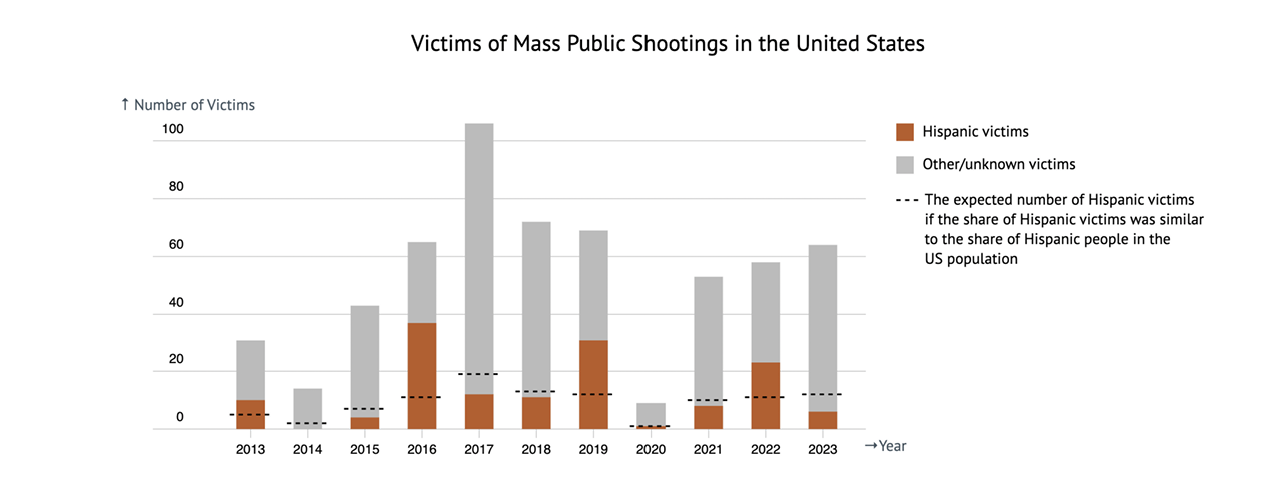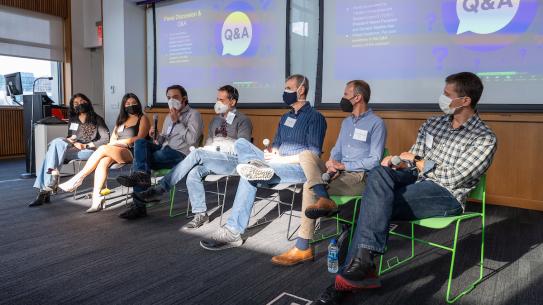Oded Nov
-
Technology Management and Innovation Department Chair
-
Morton L. Topfer Professor of Technology Management

Oded Nov is a Professor at NYU Tandon School of Engineering.
The future of work
Human-AI interaction
Digital health
Awards and Grants
- NYU Tandon Excellence in Research Award
- National Science Foundation CAREER Award
- National Academies Keck Futures Award
- MacArthur Foundation Grant
- Google Focused Research Award
- Marie Curie Fellowship
Full list:
NIH: R01: Do no digital harm? A Multilevel Evaluation of technology-Facilitated Team Care on the Patient-Provider Relationship in Health Disparity Populations. Role: Subcontract (PI: A. Schoenthaler, NYU). $3,802,540, 2023-2028.
NIH: R01: Partners IN CONTROL: Using Remote MonitorINg teChnology with cOmmuNity healTh woRkers to support hypertensiOn management for Latinx patients. Role: Subcontract (PI: D. Mann, NYU). $4,023,000, 2023-2028.
National Science Foundation: Co-Development of Telehealth, Remote Patient Monitoring, and AI-based Tools for Inclusive Technology-Facilitated Healthcare Work of the Future. Role: PI, $2,516,000, 2021-2026.
National Science Foundation: Understanding and Engineering the Ecosystem of Firearms: Prevalence, Safety, and Firearm-Related Harms. Role: Co-PI (PI: M. Porfiri, NYU), $2,055,000, 2020-2025.
National Science Foundation: Future Expert Work in the Age of "Black Box", Data-Intensive, and Algorithmically Augmented Healthcare. Role: PI (with Co-PIs Y. Aphinyanaphongs, Y. Lui, D. Mann, M. Porfiri, JR. Rizzo, B. Wiesenfeld, NYU, and M. Riedl, Georgia Tech), ($1,548,000), 2019-2025.
National Science Foundation: Learning Data Science Through Civic Engagement With Open Data. Role: PI (with Co-PIs G. Dove and C. Matuk, NYU), $300,000, 2020-2023.
National Science Foundation: Ubiqomics: HCI for Augmenting our World with Pervasive Personal and Environmental Omic Data. Role: PI (with O. Shaer, Wellesley College), NYU portion: $258,000, 2018-2022.
National Science Foundation: SONYC: A Cyber-Physical System for Monitoring, Analysis and Mitigation of Urban Noise Pollution. Role: Co-PI (PI: J. Bello, NYU), $5,105,000, 2016-2022.
National Science Foundation: Transforming Robot-mediated Telerehabilitation: Citizen Science for Rehabilitation. Role: Co-PI (PI: M. Porfiri, NYU), $311,000, 2016-2021.
Financial Industry Regulatory Authority (FINRA) Foundation: Transforming Disclosure Through Interaction. Role: PI (with Co-PI J. Burke, USC), $101,000, 2016-2018.
National Science Foundation: Promoting Robotic Design and Entrepreneurship Experiences among Students and Teachers. Role: Co-PI (PI: V. Kapila, NYU), $1,040,000, 2016-2021.
National Science Foundation: Reliable Data from Heterogeneous Groups of Citizen Scientists. Role: Co-PI (PI: M. Porfiri, NYU), $100,000, 2016-2018.
The National Academies Keck Futures Award: Toward an Integrative Science of Collective Behavior. Role: PI (with Co-PIs G. Bloch, Hebrew University, and M. Porfiri, NYU) $100,000, 2015-2018.
The MacArthur Foundation: Data Visualization for Human Rights Advocacy. Role: Co-PI (PI: M. Satterthwaite, NYU), $250,000, 2015-2017.
National Science Foundation: Dynamics of Collaboration Between Humans and Engineered Systems. Role: Co-PI (with M. Porfiri, NYU), $300,000, 2015-2018.
National Science Foundation: Human-Computer Interaction for Personal Genomics: Understanding, Informing, and Empowering Users. Role: PI (with O. Shaer, Wellesley College), NYU portion: $171,000, 2014-2018.
National Science Foundation: Exploring Spear-Phishing: A Socio-Technical Experimental Framework. Role: PI (with Co-PI N. Memon, NYU), $220,000, 2014-2017.
National Science Foundation: Agency, Structure and Organization: Paths to Participation in Large-Scale Socio-Technical Systems. Role: PI (with C. Cheshire, U.C. Berkeley), NYU portion: $153,000, 2014-2018.
The National Academies Keck Futures Award: Uncovering the DNA of Social Knowledge. Role: PI (with O. Arazy, U. of Haifa, and N. Mandayam, Rutgers) ($50,000), 2013-2015.
Google Focused Research Award: Examining the Impact of Social Traces on Page Visitors Opinions and Engagement. Role: Co-PI (with M. Naaman, Cornell), $170,000, 2013-2015.
National Science Foundation: CAREER: Individual Attributes and Social Participation: Designing for Citizen Science. Role: PI, $532,000, 2012-2018.
National Science Foundation: Citizen Science Uncovers Brooklyn Atlantis: An Inter-Disciplinary Exploration of the Dynamics of Networks of Humans and Machines in Peer Production Settings. Role: PI (with M. Porfiri, NYU), $560,000, 2011-2016.
- The National Academies Keck Futures Initiative: Invited Participant, 2012, 2014, 2017.
- Marie Curie Fellowship, 2004.
Publications
S Mandal, B Wiesenfeld, A Szerencsy, W Small, V Major, S Richardson, A Schoenthaler, D Mann, O Nov. (2025). Utilization of Generative AI-drafted Responses for Managing Patient- Provider Communication. npj Digital Medicine.
Varanasi, R.A., Wiesenfeld, B.M. and Nov, O. (2025). AI Rivalry as a Craft: How Resisting and Embracing Generative AI Are Reshaping the Writing Profession. Proceedings of the ACM CHI Conference on Human Factors in Computing Systems.
Ghaiumy Anaraky, R., Schuster, A.M., Van Fossen, J., Nov, O. and Cotten, S. (2025). Increased Use of Asocial Technologies Is Associated with Reduced Well-being Among Older Adults. In Proceedings of the ACM CHI Conference on Human Factors in Computing Systems.
Ghaiumy Anaraky, R., Cartwright, M. and Nov, O. (2025). The Role of Auditory Environments and Anxiety in Detecting Phishing Emails. In Proceedings of the Extended Abstracts of the ACM CHI Conference on Human Factors in Computing Systems.
Mandal, S., Wiesenfeld, B., Mann, D., Nov, O. (2025). The" New" New Normal: Changes in Telemedicine Utilization Since COVID-19. The American Journal of Managed Care, 31(3):74-78.
Mendel, T., Singh, N., Mann, D.M., Wiesenfeld, B. and Nov, O. (2025). Laypeople’s Use of and Attitudes Toward Large Language Models and Search Engines for Health Queries: Survey Study. Journal of Medical Internet Research, 27, p.e64290.
Mandal, S., Wiesenfeld, B., Mann, D., Szerencsy, A., Iturrate, E., and Nov, O. (2024). Quantifying the Impact of Telemedicine and Patient Medical Advice Request Messages on Physicians’ Inbasket Work. NPJ Digital Medicine 7,1,35.
Mendel, T., Nov, O. and Wiesenfeld, B. (2024). Advice from a Doctor or AI? Understanding Willingness to Disclose Information Through Remote Patient Monitoring to Receive Health Advice. Proceedings of the ACM on Human-Computer Interaction: CSCW.
Ghaiumy Anaraky, R., Li, Y., Cho, H., Huang, D.Y., Byrne, K.A., Knijnenburg, B. and Nov, O. (2024). Personalizing Privacy Protection With Individuals' Regulatory Focus: Would You Preserve or Enhance Your Information Privacy? Proceedings of the CHI Conference on Human Factors in Computing Systems.
Talkad Sukumar, P., Porfiri, M., Nov, O. (2024). Connections Beyond Data: Exploring Homophily With Visualizations. IEEE VIS.
Small, W., Wiesenfeld, B., Brandfield-Harvey, B., Jonassen, Z., Mandal, S., Stevens, E., Major, V., Lostraglio, E., Szerencsy, A., Jones, S., Aphinyanaphongs, Y., Johnson, S., Nov, O., Mann, D. (2024) Large Language Model-Based Responses to Patients’ In-Basket Messages. JAMA Network Open, v.7.
Talkad Sukumar, P., Porfiri, M., Nov, O. (2024). Are Mass Shootings in the U.S. Increasing? Understanding How Differing Definitions of Politically Charged Events Impact People’s Perceptions of Expected Trends in Visualizations. IEEE Computer Graphics and Applications.
Dove, G., Guthmann, M.R., Charvet, L., Nov, O. and Pilloni, G. (2024). "Data Is One Thing, But I Want To Know The Story Behind": Designing For Self-Tracking and Remote Patient Monitoring In The Context Of Multiple Sclerosis Care. In Proceedings of the 2024 ACM Designing Interactive Systems Conference (pp. 597-618).
Nov, O., Singh, N., Mann, D.M. (2023). Putting ChatGPT’s Medical Advice to the (Turing) Test. JMIR Medical Education, 9(1), p.e46939.
Lawrence, K., Singh, N., Jonassen, Z., Groom, L., Alfaro-Arias, V., Mandal, S., Schoenthaler, A., Mann, D., Nov, O., Dove, G. (2023). Operational Implementation of Remote Patient Monitoring Within a Large Ambulatory Health System: Multimethod Qualitative Case Study. JMIR Human Factors 10 (1) e45166.
Anand, S., Arazy, O., Mandayam, N. and Nov, O. (2023). A game-theoretic analysis of Wikipedia’s peer production: The interplay between community’s governance and contributors’ interactions. Plos one, 18(5), p.e0281725.
Bell, A., Nov, O. and Stoyanovich, J. (2023). Think about the stakeholders first! Toward an algorithmic transparency playbook for regulatory compliance. Data & Policy, 5, p.e12.
Dove, G., Shanley, J., Matuk, C., & Nov, O. (2023). Open Data Intermediaries: Motivations, Barriers and Facilitators to Engagement. Proceedings of the ACM on Human-Computer Interaction, 7(CSCW1), 1-22.
Wiesenfeld, B., Aphinyanaphongs, Y., Nov, O. (2022). Model Transferability in Healthcare: a Sociotechnical Perspective. Nature Machine Intelligence 4 (10) 807-809.
Lawrence, K., Nov, O., Mann, D., Mandal, S., Iturrate, E., Wiesenfeld, B. (2022). The Impact of Telemedicine on Physicians’ After-hours Electronic Health Record “Work Outside Work” During the COVID-19 Pandemic: Retrospective Cohort Study. JMIR Medical Informatics 10(7).
Dove, G., Fernando, A., Hertz, K., Kim, J., Rizzo, JR., Seiple, W., Nov, O. (2022). Digital Technologies In Orientation And Mobility Instruction For People Who Are Blind Or Have Low Vision. Proceedings of the ACM on Human-Computer Interaction (CSCW).
Mandal, S, Wiesenfeld, B., Mann, D., Lawrence, K., Chunara, R., Testa, P., Nov, O. (2022). Evidence for telemedicine’s ongoing transformation of healthcare delivery since the onset of COVID-19: A retrospective observational study. JMIR Formative Research.
Dove, H., Mydlarz, C., Fries, D., Chen, S., Johnson, V., Bello, JP., Nov, O. (2022). From Environmental Monitoring to Mitigation Action: Considerations, Challenges, and Opportunities for HCI. Proceedings of the ACM on Human Computer Interaction (CSCW).
Seals, A., Pilloni, G., Kim, J., Sanchez, R., Rizzo, JR., Charvet, L., Nov, O. Dove, G. (2022). ‘Are They Doing Better In The Clinic Or At Home’: Understanding Clinicians’ Needs When Visualizing Wearable Sensor Data Used In Remote Gait Assessments For People With Multiple Sclerosis. Proceedings of the ACM Conference on Human Factors in Computing Systems (CHI).
Bell, A., Solano-Kamaiko, I., Nov, O., Stoyanovich, J. (2022). It’s Just Not That Simple: An Empirical Study of the Accuracy-Explainability Trade-off in Machine Learning for Public Policy. ACM Conference on Fairness, Accountability, and Transparency (ACM FAccT).
Mendez Mendez, A., Cartwright, M., Bello, JP., Nov, O. (2022). Eliciting Confidence for Improving Crowdsourced Audio Annotations. Proceedings of the ACM on Human Computer Interaction (CSCW).
Lawrence, K., Nov, O., Mann, D., Mandal, S., Iturrate, E., Wiesenfeld, B. (2022). Virtual Work Outside Work: The Impact of Telemedicine on Physicians’ After-Hours EHR Work During the COVID-19 Pandemic. JMIR Medical Informatics.
Dove, G., Mydlarz, C., Bello, J.P. and Nov, O. (2022). Sounds of New York City. ACM Interactions, 29(3), pp.32-35.
Shaer, O., Otiono, J., Qian, Z., Seals, A., Nov, O. (2022). Remote Evaluation of Augmented Reality Interaction with Personal Health Information. Frontiers in Computer Science.
Barak-Ventura, R., Stewart-Hughes, K., Nov, O., Raghavan, P., Marín Ruiz, M., Porfiri, M. (2022). Data-driven classification of human movements in virtual reality-based serious games: A pre-clinical rehabilitation study in citizen science. JMIR Serious Games.
Balestra, M., Chen, J., Iturrate, E., Aphinyanaphongs, Y., and Nov, O. (2021). Predicting Inpatient Pharmacy Order Interventions Using Provider Action Data. JAMIA Open 2021.
Yuan, J., Nov, O., and Bertini, E. (2021). An Exploration and Validation of Visual Factors in Understanding Classification Rule Sets. Proceedings of IEEE InfoVis 2021. (pdf)
Nov, O., Aphinyanaphongs, A., Lui Y., Mann D., Porfiri, M., Riedl, M., Rizzo, JR, and Wiesenfeld, B. (2021). The Transformation of Patient-Clinician Relationships with AI-Based Medical Advice: A “Bring Your Own Algorithm” Era in Healthcare. Communications of the ACM 64(3) 46-48.
Seals, A., Olaosebikan, M., Otiono, J., Shaer, O., and Nov, O. (2021). Effects of Self-Focused Augmented Reality on Health Perceptions During the COVID-19 Pandemic: A Between-Subject Web-Based Experiment. Journal of Medical Internet Research 23 (6).
Chunara, R., Zhao, Y., Chen, J., Lawrence, K., Testa, P., Nov, O., and Mann, D. (2021). Telemedicine and Healthcare Disparities: A Cohort Study in a Large Healthcare System in New York City During COVID-19. Journal of the American Medical Informatics Association 28(1) 33-41.
Barak-Ventura, R., Ruiz Marin, M., Nov, O., Raghavan, P., and Porfiri, M. (2021). A Low-Cost Telerehabilitation Paradigm for Bimanual Training. IEEE/ASME Transactions on Mechatronics.
Nov, O., Dove, G., Balestra, M., Lawrence, K., Mann, D. and Wiesenfeld, B. (2021). Preferences and patterns of response to public health advice during the COVID-19 pandemic. Scientific Reports 11, 21700.
Poretski, L., Arazy, O., Lanir, J., and Nov, O. (2021). Who Owns What? Psychological Ownership in Shared Augmented Reality. International Journal of Human-Computer Studies.
Yuan, J., Nov, O. and Bertini, E. (2021). Visualizing Rule Sets: Exploration and Validation of a Design Space. arXiv preprint arXiv:2103.01022.
Holland, J. G., Nakayama, S., Porfiri, M., Nov, O., and Bloch, G. (2021). Body size and behavioural plasticity interact to influence the performance of free-foraging bumble bee colonies. Insects 12, 236.
Dove, G., Balestra, M., Mann, D., and Nov, O. (2020). Good for the Many or Best for the Few? A Dilemma in the Design of Algorithmic Advice. Proceedings of the ACM on Human-Computer Interaction. 4,2 (CSCW). (pdf)
Mann, D., Chen, J., Chunara, R., Testa, P., and Nov, O. (2020). COVID-19 Transforms Healthcare Through Telemedicine: Evidence From the Field. Journal of the American Medical Informatics Association 27(7) 1132–1135.
Caplin, A., Csaba, D., Leahy, J., and Nov, O. (2020). Rational Inattention, Competitive Supply, and Psychometrics. Quarterly Journal of Economics 135(3) 1681–1724. (pdf)
Nakayama, S., Richmond, S., Nov, O. and Porfiri, M. (2020). The gold miner’s dilemma: Use of information scent in cooperative and competitive information foraging. Computers in Human Behavior 109, 106352
Barak Ventura, R., Rizzo, A., Nov, O., and Porfiri, M. (2020). A 3D printing approach toward targeted intervention in telerehabilitation. Scientific Reports.10(1) 1-13.
Cartwright, M., Dove, G., Mendez, A.E., Bello, J.P., and Nov, O. (2019). Crowdsourcing Multi-label Audio Annotation Tasks with Citizen Scientists. Proceedings of the ACM SIGCHI Conference on Human Factors in Computing Systems (CHI 2019). (pdf)
Poretski, L., Arazy, O., Lanir, J., Shalev, S., and Nov, O. (2019). Virtual Objects in the Physical World: Relatedness and Psychological Ownership in Augmented Reality. Proceedings of the ACM SIGCHI Conference on Human Factors in Computing Systems (CHI 2019).
Otiono, J., Olaosebikan, M., Shaer, O., Nov, O., and Ball, M. (2019). Understanding Users Information Needs and Collaborative Sensemaking of Microbiome Data. Proceedings of the ACM on Human Computer Interaction (CSCW).
Nakayama, S., Tolbert, T., Nov, O., and Porfiri, M. (2019). Social Information as a Means to Enhance Engagement in Citizen Science-Based Telerehabilitation. Journal of the Association for Information Science and Technology. 70(6), 587-595. (pdf)
Bello, J.P., Silva, C., Nov, O., DuBois, R.L., Arora, A., Salamon, J., Mydlarz, C., and Doraiswamy, H. (2019). SONYC: A System for the Monitoring, Analysis and Mitigation of Urban Noise Pollution. Communications of the ACM. 62(2) 68-77.(pdf)
Ventura, R. B., Nakayama, S., Raghavan, P., Nov, O., and Porfiri, M. (2019). The Role of Social Interactions in Motor Performance: Feasibility Study Toward Enhanced Motivation in Telerehabilitation. Journal of medical Internet research 21(5), e12708
Machado, T., Gopstein, D., Nov, O., Wang, A., Nealen, A., & Togelius, J. (2019). Evaluation of a Recommender System for Assisting Novice Game Designers. arXiv preprint arXiv:1908.04629.
Nakayama, S., Torre, M., Nov, O., & Porfiri, M. (2019). Matching individual attributes with task types in collaborative citizen science. PeerJ Computer Science.
Tzovaras, B.G., Angrist, M., Arvai, K., Dulaney, M., Estrada-Galiñanes, V., Gunderson, B., Head, T., Lewis, D., Nov, O., Shaer, O. and Tzovara, A., (2019). Open Humans: A platform for participant-centered research and personal data exploration. BioRxiv, p.469189.
Gunaratne, J., Zalmanson, L., and Nov, O. (2018). The Persuasive Power of Algorithmic and Crowdsourced Advice. Journal of Management Information Systems 35 (4) 1092-1120.
Nov, O. and Su, H. (2018). Eliciting Users’ Demand for Interface Features. Proceedings of the ACM SIGCHI Conference on Human Factors in Computing Systems (CHI 2018). Best Paper Honorable Mention. (pdf)
Cartwright, M., Seals, A., Salamon, J., Williams, A., Mikloska, S., MacConnell, D., Law, E., Bello, J. and Nov, O. (2017). Seeing Sound: Investigating the Effects of Visualizations and Complexity on Crowdsourced Audio Annotations. Proceedings of the ACM on Human Computer Interaction 1 (2) 29. (CSCW). (pdf)
Balestra, M., Zalmanson, L., Cheshire, C., Arazy, O. and Nov, O. (2017). It Was Fun, But Did it Last? The Dynamic Interplay Between Fun Motives and Peer-Production Contributors’ Activity. Proceedings of the ACM on Human Computer Interaction 1 (2), 21 (CSCW). (pdf)
Gunaratne, J. and Nov, O. (2017). Using Interactive “Nutrition Labels” for Financial Products to Assist Decision Making Under Uncertainty. Journal of the Association for Information Science and Technology. Forthcoming. (pdf)
Balestra, M., Cheshire, C., Arazy, and Nov, O.,(2017). Investigating the Motivational Paths of Peer Production Newcomers. Proceedings of the ACM SIGCHI Conference on Human Factors in Computing Systems (CHI 2017). (pdf)
Boy, J., Pandey, A., Emerson, J., Satterthwaite, M., Nov, O. and Bertini, E. (2017). Connecting Data with People: Does Anthropomorphizing Visualizations Elicit More Empathy for Human Rights Data? Proceedings of the ACM SIGCHI Conference on Human Factors in Computing Systems (CHI 2017).
Arazy, O. Lifshitz, H., Nov, O., Daxenberg, J., Balestra, M. and Cheshire, C. (2017). On the “How” and “Why” of Emergent Role Behaviors in Wikipedia. Proceedings of the ACM SIGCHI Conference on Computer Supported Cooperative Work (CSCW 2017). (pdf)
Gunaratne, J., Burke, J. and Nov, O. (2017). Empowering Investors with Social Annotation When Saving for Retirement. Proceedings of the ACM SIGCHI Conference on Computer Supported Cooperative Work (CSCW 2017). (pdf)
Shaer, O., Nov, O., Okerlund, J., Balestra, M., Stowell, E., Westendorf, L., Pollalis, C., Davis, J., Westendorf, L. and Ball, M. (2016). GenomiX: A Novel Interaction Tool for Self-Exploration of Personal Genomic Data. Proceedings of the ACM SIGCHI Conference on Human Factors in Computing Systems (CHI 2016). (pdf)
Balestra, M., Arazy, O., Cheshire, C., and Nov, O. (2016). Motivational Determinants of New Editors’ Behavior in Wikipedia. Proceedings of the AAAI International Conference on Weblogs and Social Media (ICWSM 2016). (pdf)
Arazy, O. Daxenberg, J., Lifshitz, H. Nov, O., and Gurevych, I. (2016). Turbulent Stability of Emergent Roles: The Dualistic Nature of Self-Organizing Knowledge Co-Production. Information Systems Research. Forthcoming. (pdf)
Balestra, M., Shaer, O., Okerlund, J., Westendorf, L., Ball, M. and Nov, O. (2016). Social Annotation Valence: The Impact on Online Informed Consent Beliefs and Behavior. Journal of Medical Internet Research (JMIR). Forthcoming.
Laut, J., Cappa, F., Nov, O., and Porfiri, M. (2016). Increasing Citizen Science Contribution Using a Virtual Peer. Journal of the Association for Information Science and Technology. Forthcoming. (pdf)
Balestra, M., Shaer, O., Okerlund, J., Ball, M. and Nov, O. (2016). The Effect of Exposure to Social Annotation on Online Informed Consent Beliefs and Behavior. Proceedings of the ACM SIGCHI Conference on Computer Supported Cooperative Work (CSCW 2016). (pdf)
Cappa, F., Laut, J., Nov, O., Giustiniano, L., and Porfiri, M. (2016). Activating social strategies: Face-to-face interaction in technology-mediated citizen science. Journal of Environmental Management. Forthcoming.
Satterthwaite, M., Rall, K., Pandey, A., Emerson, J., Boy, J., Nov, O., and Bertini, E. (2016). Data Visualization for Human Rights Advocacy. Journal of Human Rights Practice 8 (2) 171-197.
Arazy, O. Gellatly, I. Brainin, E. and Nov, O. (2016). Motivation to Share Knowledge using Wiki Technology and the Moderating Effect of Role Perceptions. Journal of the Association for Information Science and Technology 67 (10) 2362–2378. (pdf)
Nov, O., Laut, J., and Porfiri, M. (2016). Using Targeted Design Interventions to Encourage Extra-Role Crowdsourcing Behavior. Journal of the Association for Information Science and Technology 67 (2) 483–489.
Gunaratne, J. and Nov, O. (2015). Informing and Improving Retirement Saving Performance Using Behavioral Economic Theory-Driven User Interfaces. Proceedings of the ACM SIGCHI Conference on Human Factors in Computing Systems (CHI 2015). (pdf)
Pandey, A., Rall, K., Satterthwaite, M., Nov, O. and Bertini, E. (2015). How Deceptive are Deceptive Visualizations?: An Empirical Analysis of Common Distortion Techniques. Proceedings of the ACM SIGCHI Conference on Human Factors in Computing Systems (CHI 2015). (pdf)
Arazy, A., Ortega, F., Nov, O., Yeo, L., and Balila, A. (2015). Functional Roles within Wikipedia: Organizational Structure and Career Paths. Proceedings of the ACM SIGCHI Conference on Computer Supported Cooperative Work (CSCW 2015). (pdf)
Gunaratne, J. and Nov, O. (2015). Influencing Retirement Saving Behavior With Expert Advice and Social Comparison as Persuasive Techniques. Proceedings of the 10th International Conference on Persuasive Technology (PERSUASIVE 2015). (pdf)
Nov, O. and Arazy, A. (2015). Asymmetric Recommendations: The Interacting Effects of Social Ratings’ Direction and Strength on Users’ Ratings. Proceedings of the ACM Recommender Systems Conference (RecSys 2015). (pdf)
Shaer, O., Nov, O., Okerlund, J., Balestra, M., Stowell, E., Ascher, L., Bi, J., Schlenker, C., and Ball, M. (2015). Informing the Design of Direct-to-Consumer Interactive Personal Genomics Reports. Journal of Medical Internet Research (JMIR) 17(6):e146.
Laut, J., Cappa, F., Nov, O., and Porfiri, M. (2015). Increasing Patient Engagement in Rehabilitation Exercises Using Computer-Based Citizen Science. PLoS One 10 (3) e0117013.
Arazy, O., Nov, O., and Kumar, N. (2015). Personalityzation: UI Personalization, Theoretical Grounding in HCI and Design Research. AIS Transactions on Human-Computer Interaction. 7 (2) 43-69 (pdf)
Pandey, A., Manivannan, A., Nov, O., Satterthwaite, M., and Bertini, E. (2014). The Persuasive Power of Data Visualization. Proceedings of IEEE InfoVis 2014. (pdf)
Nov, O., Arazy, O., and Anderson, D. (2014). Scientists@home: What Drives the Quantity and Quality of Volunteers’ Technology-Mediated Citizen Science Participation? PLoS One 9 (4) e90375 (HTML)
Shaer, O. and Nov, O. (2014). HCI for Personal Genomics: Understanding, Informing and Empowering Non-Experts. ACM Interactions 21 (5) 33-37. (pdf)
Laut, J., Henry, E., Nov, O., and Porfiri, M. (2014). Development of a Mechatronics-Based Citizen Science Platform for Aquatic Environmental Monitoring. IEEE Transactions on Mechatronics 19 (5) 1541-1551.
Shaer, O., Nov, O., West, A., and Eastman, D. (2014). Understanding Information Practices of Interactive Personal Genomics Users. Extended Abstracts on Human Factors in Computing Systems (CHI 2014). (pdf)
Laut, J., Nelson Wright, S., Nov, O., and Porfiri, M. (2014). Gowanus Voyage: Where Mechatronics, Public Art, Community Members, and Environmental Science Meet. IEEE Control Systems 34 (1) 60-64.
Nov, O., Arazy, O., Lopez, C. and Brusilovsky, P. (2013). Exploring Personality-Targeted UI Design in Online Social Participation Systems. Proceedings of the ACM SIGCHI Conference on Human Factors in Computing Systems (CHI 2013). (pdf)
Nov, O. and Arazy, O. (2013). Personality-Targeted Design: Theory, Experimental Procedure, and Preliminary Results. Proceedings of the ACM SIGCHI Conference on Computer Supported Cooperative Work (CSCW 2013). (pdf)
Cappa, P., Clerico, A., Nov, O.and Porfiri, M. (2013). Can Force Feedback and Science Learning Enhance the Effectiveness of Neurorehabilitation? An Experimental Study on Using a Low-Cost 3D Joystick and a Virtual Visit to a Zoo. PLoS One 8 (12) e77589.
Anand S., Arazy O., Mandayam N., and Nov O. (2013). A Game Theoretic Analysis of Collaboration in Wikipedia. Proceedings of the 4th Conference on Decision and Game Theory for Security (GameSec 2013). (pdf)
Dwyer, P. C., Bono, J. E., Snyder, M., Nov, O., & Berson, Y. (2013). Sources of Volunteer Motivation: Transformational Leadership and Personal Motives Influence Volunteer Outcomes. Nonprofit Management and Leadership 24 (2) 181-205.
Nov, O., Arazy, O., Lotts, K. and Naberhaus, T. (2013). Motivation-Targeted Personalized UI Design: A Novel Approach to Enhancing Citizen Science Participation. Proceedings of the 13th European Conference on Computer Supported Cooperative Work (ECSCW 2013).
Arazy, O., Yeo, L and Nov, O. (2013). Stay on the Wikipedia Task: When Task-Related Disagreements Slip into Personal and Procedural Conflicts. Journal of the American Society for Information Science and Technology (JASIST) 64 (8) 1634-1648. (pdf)
Mitra, R., Johri, A., and Nov, O. (2013). The Effects of External Events on Newcomer Participation in Open Source Online Communities. First Monday. 18(6).
Ye, C. and Nov, O. (2013). Exploring User Contributed Information in Social Computing Systems: Quantity versus Quality. Online Information Review 37 (5) 752-770.
Antin, J., Cheshire,C., and Nov, O. (2012). Technology-Mediated Contributions: Editing Behaviors Among New Wikipedians. Proceedings of the ACM SIGCHI Conference on Computer Supported Cooperative Work (CSCW 2012). (pdf)
Nov, O. Ye, C. and Kumar, N. (2012). A Social Capital Perspective on Meta-Knowledge Contribution. Decision Support Systems 53 (1) 118-126.
Nov, O. and Schecter, W. (2012). Dispositional Resistance to Change and Hospital Physicians’ Use of Electronic Medical Records. Journal of the American Society for Information Science and Technology 63 (4) 648-656.
Nov, O., Arazy, O., and Anderson, D. (2011). Dusting for Science: Motivations and Participation of Digital Citizen Science Volunteers. iConference 2011. Best Paper Award. (pdf)
Arazy, A., Nov, O., Patterson, R. and Yeo, L. (2011). Information Quality in Wikipedia: The Effects of Group Composition and Task Conflict. Journal of Management Information Systems 27 (4) 73-100. (pdf)
Russo, P. and Nov, O. (2011). Trusting Social Location Technologies and Interactions. International Conference on Information Systems (ICIS 2011).
Antin, J., Yee, R., Cheshire,C., and Nov, O. (2011). Gender Differences in Wikipedia Editing. WikiSym’11. Mountain View, CA, October 2011. Best Short Paper Award.
Nov, O., Arazy, O., and Anderson, D. (2011). Technology-Mediated Citizen Science Participation: A Motivational Model. Proceedings of the AAAI International Conference on Weblogs and Social Media (ICWSM 2011).
Johri, A., Nov, O., and Mitra, R. (2011). Environmental Jolts: Impact of Exogenous Factors on Online Community Participation. Proceedings of the ACM Conference on Computer Supported Cooperative Work (CSCW 2011).
Nov, O., Anderson, D. and Arazy, O. (2010). Volunteer Computing: a Model of the Factors Determining Contribution to Community-Based Scientific Research. Proceedings of the 19th International World Wide Web Conference (WWW 2010). (pdf)
Russo, P. and Nov, O. (2010). Photo Tagging Over Time: A Longitudinal Study of the Role of Attention, Network Density, and Motivations. Proceedings of AAAI International Conference on Weblogs and Social Media (ICWSM 2010).
Arazy, O. and Nov, O. (2010). Determinants of Wikipedia Quality: the Roles of Global and Local Contribution Inequality. Proceedings of the ACM Conference on Computer Supported Cooperative Work (CSCW 2010). (pdf)
Nov, O., Arazy, O. and Anderson, D. (2010). Crowdsourcing for Science: Understanding and Enhancing ScienceSourcing Contribution. Workshop on the Changing Dynamics of Scientific Collaborations at the ACM Conference on Computer Supported Cooperative Work (CSCW 2010). (pdf)
Nov, O. and Ye, C. (2010). Why do People Tag? Motivations for Collaborative Content Tagging. Communications of the ACM 53 (7) 128-131.
Nov, O. Naaman, M. and Ye, C. (2010). Analysis of Participation in an Online Photo Sharing Community: A Multi-Dimension Perspective. Journal of the American Society for Information Science and Technology 61 (3) 555-566. (pdf)
Nov, O. and Ye, C. (2009). Why do People Share Photos Online? Antecedents of photos’ Quality and Quantity. Proceedings of the Americas Conference on Information Systems (AMCIS 2009).
Nov, O., Naaman, M., and Ye, C. (2009). Motivational, Structural and Tenure Factors that Impact Online Community Photo Sharing. Proceedings of AAAI International Conference on Weblogs and Social Media (ICWSM 2009). Best Paper Award. (pdf))
Nov, O. and Wattal, S. (2009). Social Computing and Privacy Concerns: Antecedents and Effects. Proceedings of CHI 2009: ACM Conference on Human Factors in Computing Systems (CHI 2009). (pdf)
Nov, O. (2009). Information Sharing and Social Computing: Why, What and Where? In: Zelkowitz, M. (Ed.), Advances in Computers, 76, 1-18. Elsevier, Academic Press.
Nov, O. and Rafaeli, S. (2009). Measuring the Premium on Common Knowledge in Computer-Mediated Coordination Problems. Computers in Human Behavior 25 (1) 171-174.
Nov, O. and Ye, C. (2009). Resistance to Change and the Adoption of Digital Libraries: An Integrative Model. Journal of the American Society for Information Science and Technology 60 (8) 1702-1708. (pdf)
Nov, O. and Ye, C. (2008). Community Photo Sharing: Motivational and Structural Antecedents. Proceedings of the 29th International Conference on Information Systems (ICIS 2008), (pdf)
Nov, O., Naaman, M. and Ye, C. (2008). What Drives Content Tagging: The Case of Photos on Flickr. Proceedings of CHI 2008: ACM Conference on Human Factors in Computing Systems (CHI 2008) (pdf)
Nov, O. and Ye, C. (2008). Personality and technology acceptance: The case for personal innovativeness in IT, openness and resistance to change. Proceedings of the 41st Hawaii International Conference on System Sciences (HICSS 41). IEEE Press.
Nov, O. and Rao, B. (2008). Technology-Facilitated ‘Give According to Your Abilities, Receive According to Your Needs’. Communications of the ACM 51 (5) 83-87. (pdf)
Nov, O. and Ye, C. (2008). Users’ Personality and Perceived Ease of Use of Digital Libraries: The Case for Resistance to Change. Journal of the American Society for Information Science and Technology 59 (5) 845-851. (pdf)
Nov, O. and Kuk, G. (2008). Open Content Contributors’ Response to Free Riding: The Roles of Personality and Context. Computers in Human Behavior 24 (6) 2848-2861.
Nov, Y. and Nov, O. (2008). Living In a Bubble? Toward a Unified Bubble Theory. International Journal of General Systems 37 (5) 627-635. (pdf)
Oreg, S. and Nov, O. (2008). Exploring Motivations for Contributing to Open Source Initiatives: The Roles of Contribution Context and Personal Values. Computers in Human Behavior 24 (5) 2055-2073. (pdf)
Nov, O. (2007). What Motivates Wikipedians. Communications of the ACM 50 (11) 60-64. (pdf)
Rao, B., Angelov, B. and Nov, O. (2006). Fusion of Disruptive Technologies: Lessons from the Skype Case. European Management Journal 24 (2-3) 174-188.
Nov, O. and Jones, M. (2006). Ordering Creativity: Knowledge, Creativity and Idea Generation in the Advertising Industry. International Journal of Product Development 3 (2) 252-262.
Nov, O. and Jones, M. (2006). Knowledge management and creativity: A technology-facilitated balance. Proceedings of the 14th European Conference on Information Systems (ECIS 2006).
B. Rao, Angelov, B. and Nov, O. (2005). When disruptive technologies integrate: evidence from the Skype case. Proceedings of the 14th International Conference on Management of Technology (IAMOT)
Nov, O. and Jones, M. (2005). Creativity, knowledge and IS: a critical view. Proceedings of the 38th Hawaii International Conference on System Sciences (HICSS 38). IEEE Press.
Nov, O. and Jones, M. (2004). Information systems and creativity management in the media and advertising industries: a critical view. Proceedings of the 12th European Conference on Information Systems (ECIS 2004).
Research News
New research reveals uptake of AI-powered messaging in healthcare settings
A new study from NYU Tandon, NYU Langone Health, and the NYU Stern School of Business offers one of the first data-driven looks at how generative AI might help healthcare providers manage their message overload — and why many are hesitant to adopt the technology.
Over a ten-month period from October 2023 through August 2024, a team led by Morton L. Topfer Professor of Technology Management Oded Nov observed more than 55,000 patient messages sent to healthcare providers through a secure online patient portal. The system used an embedded generative AI tool that automatically generated draft replies for incoming patient messages; healthcare providers could choose to start with the draft, begin a reply from scratch, or use their usual reply interface.
The research was published in npj Digital Medicine.
“This paper provides evidence that AI has the potential to make patient-provider communication more efficient and more responsive,” says Soumik Mandal, research scientist and lead author of the research. “To unlock its full potential in the next phase, however, will require tailored implementation to ensure that AI tools meaningfully reduce clinician burden while enhancing care quality. The paper outlines some practical strategies to improve draft utilization and guide future implementation efforts as key next steps.”
Other authors include NYU Stern’s Batia M. Wiesenfeld, as well as NYU Langone Health’s Adam C. Szerencsy, William R. Small, Vincent Major, Safiya Richardson, Antoinette Schoenthaler, and Devin Mann.
According to the published results, providers chose to “Start with Draft” in 19.4 percent of cases where a draft was shown. Adoption rose modestly over the course of the study as the system’s prompting improved. Using a draft shaved roughly 7 percent off response times, a median of 331 seconds versus 355 seconds when drafting from scratch, but in many cases, this time saved was offset by time spent reviewing, editing, or ignoring drafts.
“LLMs are a new technology that can help providers be more responsive, more effective and more efficient in their communication with their patients,” says Nov. “The more we understand who uses it and why, the better we can leverage it.”
By analyzing tens of thousands of messages, the researchers found that certain qualities made drafts more likely to be used. Shorter, more readable, and more informative drafts tended to be preferred. Tone also mattered: messages that sounded slightly more human and empathetic were more likely to be adopted, though the ideal balance differed by role. Physicians leaned toward concise, neutral text, while support staff were more receptive to messages with a warmer tone. These preferences hint at a future where AI systems could adapt their writing style based on the user’s role or communication history.
Still, the study shows how hesitant healthcare providers remain to rely on AI-generated language at all. The authors suggest several possible reasons including suboptimal alignment with clinical workflows, and the cognitive cost of reviewing a constant stream of AI output, much of which may be irrelevant. Simply generating text for every message, they argue, can create clutter that undermines the very efficiency such tools are meant to provide.
The researchers see ample opportunity ahead. Future systems may need to learn each user’s style, selectively generate drafts only for messages likely to benefit, and continuously adapt prompt strategies.
Mandal, Soumik, et al. Utilization of Generative AI-Drafted Responses for Managing Patient-Provider Communication, 2 Sept. 2025, https://doi.org/10.1101/2025.08.31.25334725.
"Rivalry as a Craft": NYU study reveals how writers compete with AI
Writers are not passive victims of AI disruption but active crafters of their professional futures, according to new research from New York University presented at The ACM CHI conference on Human Factors in Computing Systems in Yokohama, Japan.
Generative AI technologies are transforming the writing profession, eliciting opposing reactions. "If I let AI do my work, it would make me miserable inside," one screenwriter told researchers, while a paralegal countered, "individuals who are not using it are at a serious disadvantage."
The study was overseen by NYU Tandon's Oded Nov (Morton L. Topfer Professor of Technology Management) with lead author Rama Adithya Varanasi (Postdoctoral Researcher at NYU Tandon) and Batia Mishan Wiesenfeld (Professor of Management at NYU Stern). The team interviewed 25 professional writers with an average of 17 years of experience, all with at least 12 months of exposure to generative AI.
Using 'job crafting' theory, which examines how workers redesign their roles to derive greater meaning from their work, the researchers identified four distinct strategies that writing professionals employ in response to generative AI — two focused on resistance and two on adoption.
- Human-driven expansion (AI Resisters): Writers strengthen their identity by making their human labor visible, building personal brands, and forming collaborations.
- Human-driven localization (AI Resisters): Writers create niche identities, appeal to selective audiences that value human work, and sometimes reduce quality to compete with AI's speed.
- Generative AI-driven expansion (AI Adopters): Writers use AI to enhance creative workflows, generate alternatives, overcome blocks, and assist with challenging communications.
- Generative AI-driven delegation (AI Adopters): Writers offload tedious tasks to AI, reduce emotional labor, and minimize dependencies on colleagues.
The research uncovered significant evidence of "AI rivalry" among some resistors — professionals actively competing against AI rather than simply avoiding it. Writers employing resistance strategies deliberately target what they perceive as AI's weaknesses, such as its limited ability to generate content specific to a geographic area, community, or context.
"I'm taking steps to be more independent," one SEO writer shared. "I have started 11 websites. The baking website is my best contender." Many writers are creating revenue streams where they own the content, anticipating industry disruption.
Meanwhile, adopters engage in significant "AI managerial labor" — the invisible work of designing prompts, cleaning outputs, and verifying results. This requires substantial workflow changes, as one paralegal noted: "With ChatGPT, I need to block two to three hours to complete the prompting... If I leave it mid-way... it is extremely difficult to follow the reasoning."
Economic implications loom large, as some senior professionals eliminated dependencies on junior writers. "The difference now is that I'm not dealing with a lot of writers; I'm not giving them therapy sessions," said one publishing house owner who replaced staff with ChatGPT.
A key distinction emerged: resisters shape both identities and practices, while adopters focus primarily on practices without significant identity work. This stems from AI's anthropomorphizing features, which some writers perceive as competing with their creative identities.
Varanasi emphasized: "Resistors engage holistically in their human potential to shape both identity and practices... We introduced the notion of AI rivalry to show resistors engaged in constructive strategies while viewing generative AI as a rival similar to how they would treat a human rival."
The researchers recommend creating communities where resisters and embracers can share insights, as both groups would benefit from understanding each other's approaches to navigating this technological transformation.
The research was supported by funding from the National Science Foundation.
Varanasi, R., Wiesenfeld, B. & Nov, O. AI Rivalry as a Craft: How Resisting and Embracing Generative AI Are Reshaping the Writing Profession. 2025 CHI Conference on Human Factors in Computing Systems. (1198). https://doi.org/10.1145/3706598.3714035
NYU Tandon study finds political views, not race, shape reactions to mass shooting data
A new study from NYU Tandon School of Engineering suggests that when it comes to visualizations of mass shooting data, political ideology plays a more significant role in shaping emotional responses than racial identity. The research challenges assumptions about how people interpret data related to gun violence.
The study involved 450 participants who were shown visualizations — in this case, bar charts — of mass shooting victim data highlighting different racial groups. Contrary to the researchers' expectations, participants did not show stronger emotional responses when viewing data about victims of their own race.
"We anticipated seeing evidence of racial homophily, the tendency for people to identify more strongly with members of their own group," said Poorna Talkad Sukumar, a postdoctoral associate in NYU Tandon’s Technology Management and Innovation Department and the lead author on the research which will be presented at VIS2024 next month. "But our findings suggest that the gravity of mass shootings as a topic may override such in-group preferences."

Data in this graph is from a real source. The source defines a mass shooting as an incident where four or more people, not including the shooter(s), were killed in a public space and not connected to another crime. Hispanic population percentage in the US for each year was obtained from census.gov.
Instead, the study found that political views were the strongest predictor of how participants reacted emotionally to the visualizations. Those with more liberal political leanings tended to have more negative emotional responses across all conditions.
Oded Nov, the NYU Tandon Morton L. Topfer Professor of Technology Management and a member of NYU Tandon’s Center for Urban Science and Progress (CUSP), is another author of the paper. He said the findings highlight the complex interplay between personal beliefs and data interpretation. "This research underscores how pre-existing ideological frameworks can shape our emotional reactions to information, even when presented in a seemingly neutral, visual format.”
Maurizio Porfiri, Director of CUSP and an Institute Professor in the Department of Mechanical and Aerospace Engineering and in the Department of Biomedical Engineering, is also an author of the paper. He suggested that “studies like this are critical to helping us identify best practices to present data on firearm violence and sensitize the general public about firearm-related harms.”
The study also revealed that even relatively simple bar charts elicited strong negative emotions from participants, regardless of their race or the racial group highlighted in the data. This finding could have implications for how sensitive topics are visually presented in media and public policy discussions.
The researchers note that their study had limitations, including a relatively small sample size, which limits the detection of subtle effects. They call for further research exploring different types of societal issues and visualization designs to better understand how viewer characteristics interact with data presentation.
As debates around gun violence and racial disparities continue to occupy national attention, this study offers valuable insights into how Americans process related information. It suggests that bridging ideological divides may be more crucial than addressing racial differences when it comes to fostering a shared understanding of mass shooting data.
This study contributes to Porfiri, Nov, and colleagues’ ongoing data-based research related to U.S. gun prevalence and violence, which they are pursuing under a 2020 $2 million National Science Foundation grant to study the “firearm ecosystem” in the United States. Prior published research under the grant explores:
- the role that population size of cities plays on the incidences of gun homicides, gun ownership and licensed gun sellers;
- motivations of fame-seeking mass shooters;
- factors that prompt gun purchases;
- state-by-state gun ownership trends; and
- forecasting monthly gun homicide rates.
arXiv:2408.03269v1 [cs.HC] 6 Aug 2024
ChatGPT’s responses to people’s healthcare-related queries are nearly indistinguishable from those provided by humans, new study reveals
ChatGPT’s responses to people’s healthcare-related queries are nearly indistinguishable from those provided by humans, a new study from NYU Tandon School of Engineering and Grossman School of Medicine reveals, suggesting the potential for chatbots to be effective allies to healthcare providers’ communications with patients.
An NYU research team presented 392 people aged 18 and above with ten patient questions and responses, with half of the responses generated by a human healthcare provider and the other half by ChatGPT.
Participants were asked to identify the source of each response and rate their trust in the ChatGPT responses using a 5-point scale from completely untrustworthy to completely trustworthy.
The study found people have limited ability to distinguish between chatbot and human-generated responses. On average, participants correctly identified chatbot responses 65.5% of the time and provider responses 65.1% of the time, with ranges of 49.0% to 85.7% for different questions. Results remained consistent no matter the demographic categories of the respondents.
The study found participants mildly trust chatbots’ responses overall (3.4 average score), with lower trust when the health-related complexity of the task in question was higher. Logistical questions (e.g. scheduling appointments, insurance questions) had the highest trust rating (3.94 average score), followed by preventative care (e.g. vaccines, cancer screenings, 3.52 average score). Diagnostic and treatment advice had the lowest trust ratings (scores 2.90 and 2.89, respectively).
According to the researchers, the study highlights the possibility that chatbots can assist in patient-provider communication particularly related to administrative tasks and common chronic disease management. Further research is needed, however, around chatbots' taking on more clinical roles. Providers should remain cautious and exercise critical judgment when curating chatbot-generated advice due to the limitations and potential biases of AI models.
The study, "Putting ChatGPT’s Medical Advice to the (Turing) Test: Survey Study," is published in JMIR Medical Education. The research team consists of NYU Tandon Professor Oded Nov, NYU Grossman medical student Nina Singh and Grossman Professor Devin M. Mann.








